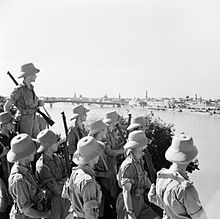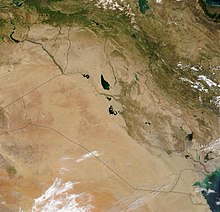There are no know images of Meher Baba for the whole of this journey from Bombay to London. This was his 9th visit to the West.
COURTESY oF WIKIPEDIA
Iraq (/ɪˈræk/, ![]() i/ɪˈrɑːk/, or /aɪˈræk/; Arabic: العراق al-‘Irāq),
officially the Republic of Iraq (Arabic:
i/ɪˈrɑːk/, or /aɪˈræk/; Arabic: العراق al-‘Irāq),
officially the Republic of Iraq (Arabic: ![]() جمهورية العراق (help·info) Jumhūriyyat al-‘Irāq; Kurdish: كۆماری عێراق), is a country in Western
Asia encompassing the Mesopotamian alluvial plain, the northwestern end of the Zagros mountain
range, and the eastern part of the Syrian Desert.[6]
جمهورية العراق (help·info) Jumhūriyyat al-‘Irāq; Kurdish: كۆماری عێراق), is a country in Western
Asia encompassing the Mesopotamian alluvial plain, the northwestern end of the Zagros mountain
range, and the eastern part of the Syrian Desert.[6]
Iraq borders Turkey to the north, Iran to the east, Kuwait to the southeast, Saudi Arabia to the south, Jordan to the southwest, and Syria to the west. Iraq has a narrow section of coastline measuring 58 km (36 mi) on the northern Persian Gulf. The capital city, Baghdad is in the center-east of the country. Two major rivers, the Tigris and Euphrates, run through the center of Iraq, flowing from northwest to southeast. These provide Iraq with agriculturally capable land and contrast with the steppe and desert landscape that covers most of Western Asia.
Iraq has been known by the Greek toponym 'Mesopotamia' (Land between the rivers) and has been home to continuous successive civilizations since the 6th millennium BC. The region between the Tigris and Euphrates rivers is often referred to as the cradle of civilization and the birthplace of writing. At different periods in its history, Iraq was the center of the indigenous Akkadian, Sumerian, Assyrian, and Babylonian empires. It was also part of the Median, Achaemenid, Hellenistic, Parthian, Sassanid, Roman, Rashidun, Umayyad, Abbasid, Mongol, Safavid, Afsharid, and Ottoman empires, and under British control as a League of Nations mandate.[7] Iraq is home to two of the world's holiest places among Shias: Najaf and Karbala.[8]
Iraq's modern borders were mostly demarcated in 1920 by the League of Nations when the Ottoman Empire was divided by the Treaty of Sèvres. Iraq was placed under the authority of the United Kingdom as the British Mandate of Mesopotamia. A monarchy was established in 1921 and the Kingdom of Iraq gained independence from Britain in 1932. In 1958, the monarchy was overthrown and the Republic of Iraq was created. Iraq was controlled by the Ba'ath Party (Iraqi-led faction) from 1968 until 2003. After an invasion led by the United States of America including multinational forces, the Ba'ath Party was removed from power and multi-party parliamentary elections were held. The American presence in Iraq ended in 2011.[9]
Name
The Arabic name العراق al-ʿIrāq has been in use since before the 6th century. There are several suggested origins for the name. One dates to the Sumerian city of Uruk (Biblical Hebrew Erech) and is thus ultimately of Sumerian origin, as Uruk was the Akkadian name for the Sumerian city of Urug, containing the Sumerian word for "city", UR.[10][11] An Arabic folk etymology for the name is "deeply rooted, well-watered; fertile".[12] During the medieval period, there was a region called ʿIrāq ʿArabī ("Arabian Iraq") for Lower Mesopotamia and ʿIrāq ʿajamī ("Foreign Iraq"),[13] for the region now situated in Central and Western Iran.[14] The term historically included the plain south of the Hamrin Mountains and did not include the northernmost and westernmost parts of the modern territory of Iraq.[15] The term Sawad was also used in early Islamic times for the region of the alluvial plain of the Tigris and Euphrates rivers, contrasting it with the arid Arabian desert. As an Arabic word, عراق means "hem", "shore", "bank", or "edge", so that the name by folk etymology came to be interpreted as "the escarpment", viz. at the south and east of the Jazira Plateau, which forms the northern and western edge of the "al-Iraq arabi" area.[16]
The Arabic pronunciation is [ʕiˈrɑːq]. In English, it is either /ɪˈrɑːk/ (the only pronunciation listed in the Oxford English Dictionary and the first one in Merriam-Webster's Online Dictionary) or /ɪˈræk/ (listed first by MQD), the American Heritage Dictionary, and the Random House Dictionary. /aɪˈræk/ is frequently heard in US media.
History
Ancient Iraq

The "Cradle of Civilization", is a common term for the area comprising modern Iraq as it was home to the earliest known civilization, the Sumerian civilization, which arose in the fertile Tigris-Euphrates river valley of southern Iraq in the Chalcolithic (Ubaid period). It was here in the late 4th millennium BC, that the world's first writing system and recorded history itself were born. The Sumerian civilization flourished for over 3,000 years[citation needed] and was succeeded by the rise of the Akkadian Empire in the 24th century BC. Over two centuries of Akkadian dominance was followed by a Sumerian Renaissance in the 21st century BC. An Elamite invasion in 2004 BC brought the Third Dynasty of Ur to an end. By the 21st century BC, a new Akkadian civilization, Assyria, had risen to dominance in northern Iraq, and by the 19th century BC a contemporaneous Amorite state, Babylonia, had formed in southern Iraq.
Iraq was to be dominated by the Assyrians and Babylonians for the next 14 centuries, and under the respective Assyrian and Babylonian empire of Shamshi-Adad I and Hammurabi in the 19th and 18th centuries BC, the Middle Assyrian Empire of 1365–1053 BC and the Neo Assyrian Empire of 911–605 BC, and the final Babylonian empire of 620–539 BC Iraq became a center of world power. The Neo Assyrian Empire in particular put Iraq at the heart of a massive empire stretching from the Caucasus to Egypt and Arabia, and from Cyprus to Persia.
In the 6th century BC, Cyrus the Great of neighbouring Persia defeated the Neo-Babylonian Empire at the Battle of Opis and Iraq was subsumed into the Achaemenid Empire for nearly two centuries. In the late 4th century BC, Alexander the Great conquered the region, putting it under Hellenistic Seleucid rule for over two centuries.[18] The Parthians (247 BC – 224 AD) from Persia conquered the region during the reign of Mithridates I of Parthia (r. 171–138 BC). From Syria, the Romans invaded western parts of the region several times. Christianity began to take hold in Iraq (particularly in Assyria) between the 1st and 3rd centuries, and Assyria became a center of the Church of the East. The Sassanids of Persia under Ardashir I destroyed the Parthian Empire and conquered the region in 224 AD. The region was thus a province of the Sassanid Empire for over four centuries, until the Muslim conquest of Persia in the mid-7th century, although a number of indigenous Neo Assyrian states evolved during the Parthian era, such as Adiabene, Osroene and Hatra.
Middle Ages
The Arab Islamic conquest in the mid 7th century AD established Islam in Iraq, and saw a large influx of Arabs and also Kurds. Under the Rashidun Caliphate, the prophet Muhammad's cousin and son-in-law Ali moved his capital to Kufa when he became the fourth caliph. The Umayyad Caliphate ruled the province of Iraq from Damascus in the 7th century. (However, eventually there was a separate, independent Caliphate of Córdoba.)
The Abbasid Caliphate built the city of Baghdad in the 8th century as their capital, and it became the leading metropolis of the Arab and Muslim world for five centuries. Baghdad was the largest multicultural city of the Middle Ages, peaking at a population of more than a million,[19] and was the centre of learning during the Islamic Golden Age. The Mongols destroyed the city during the siege of Baghdad in the 13th century.[20]

In 1257, Hulagu Khan amassed an unusually large army, a significant portion of the Mongol Empire's forces, for the purpose of conquering Baghdad. When they arrived at the Islamic capital, Hulagu Khan demanded surrender but the last Abbasid Caliph Al-Musta'sim refused. This angered Hulagu, and, consistent with Mongol strategy of discouraging resistance, Baghdad was decimated.[21] Estimates of the number of dead range from 200,000 to a million.[22]
The Mongols destroyed the Abbasid Caliphate and Baghdad's House of Wisdom, which contained countless precious and historical documents. The city has never regained its status as a major center of culture and influence. Some historians believe that the Mongol invasion destroyed much of the irrigation infrastructure that had sustained Mesopotamia for millennia. Other historians point to soil salination as the culprit in the decline in agriculture.[23]
The mid-14th-century Black Death ravaged much of the Islamic world.[24] The best estimate for the Middle East is a death rate of a third.[25]
In 1401, warlord of Mongol descent Tamerlane (Timur Lenk) invaded Iraq. After the capture of Baghdad, 20,000 of its citizens were massacred.[26] Timur ordered that every soldier should return with at least two severed human heads to show him (many warriors were so scared they killed prisoners captured earlier in the campaign just to ensure they had heads to present to Timur).[27] Timur also conducted massacres of the indigenous Assyrian Christian population, hitherto still the majority population in northern Mesopotamia, and it was during this time that the ancient Assyrian city of Assur was finally abandoned.[28]
Ottoman Iraq
During the late 14th and early 15th centuries, the Black Sheep Turkmen ruled the area now known as Iraq. In 1466, the White Sheep Turkmen defeated the Black Sheep and took control. In the 16th century, most of the territory of present-day Iraq came under the control of Ottoman Empire as the eyalet of Baghdad. Throughout most of the period of Ottoman rule (1533–1918) the territory of present-day Iraq was a battle zone between the rival regional empires and tribal alliances. The Safavid dynasty of Iran briefly asserted their hegemony over Iraq in the periods of 1508–1533 and 1622–1638.
By the 17th century, the frequent conflicts with the Safavids had sapped the strength of the Ottoman Empire and had weakened its control over its provinces. The nomadic population swelled with the influx of bedouins from Najd, in the Arabian Peninsula. Bedouin raids on settled areas became impossible to curb.[29]
During the years 1747–1831 Iraq was ruled by a Mamluk dynasty of Georgian[30] origin who succeeded in obtaining autonomy from the Ottoman Porte, suppressed tribal revolts, curbed the power of the Janissaries, restored order and introduced a program of modernization of economy and military. In 1831, the Ottomans managed to overthrow the Mamluk regime and imposed their direct control over Iraq. The population of Iraq decreased from around 30 millions around 800 AD to under 5 million by the early 20th century.[31]
During World War I, the Ottomans sided with Germany and the Central Powers. In the Mesopotamian campaign against the Central Powers, British forces invaded the country and initially suffered a major defeat at the hands of the Turkish army during the Siege of Kut (1915–1916). However, subsequent to this the British began to gain the upper hand, and were further aided by the support of local Arabs and Assyrians. In 1916, the British and French made a plan for the post-war division of Western Asia under the Sykes-Picot Agreement.[32] British forces regrouped and captured Baghdad in 1917, and defeated the Ottomans. An armistice was signed in 1918.
During World War I the Ottomans were defeated and driven from much of the area by the United Kingdom during the dissolution of the Ottoman Empire. The British lost 92,000 soldiers in the Mesopotamian campaign. Ottoman losses are unknown but the British captured a total of 45,000 prisoners of war. By the end of 1918 the British had deployed 410,000 men in the area, of which 112,000 were combat troops.
British Mandate and Kingdom
On 11 November 1920 Iraq became a League of Nations mandate under British control with the name "State of Iraq". The British established the Hashemite king, Faisal, who had been forced out of Syria by the French, as their client ruler. Likewise, British authorities selected Sunni Arab elites from the region for appointments to government and ministry offices.[specify][33][page needed]
Faced with spiralling costs and influenced by the public protestations of war hero T. E. Lawrence in The Times, Britain replaced Arnold Wilson in October 1920 with new Civil Commissioner Sir Percy Cox. Cox managed to quell the rebellion, yet was also responsible for implementing the fateful policy of close cooperation with Iraq's Sunni minority.[34] The institution of slavery was abolished in the 1920s.[35]
Britain granted independence to the Kingdom of Iraq in 1932, on the urging of King Faisal, though the British retained military bases and transit rights for their forces. King Ghazi ruled as a figurehead after King Faisal's death in 1933, while undermined by attempted military coups, until his death in 1939. Ghazi was followed by his underage son, Faisal II. 'Abd al-Ilah served as Regent during Faisal's minority.
On 1 April 1941, Rashid Ali al-Gaylani and members of the Golden Square staged a coup d'état and overthrew the government of 'Abd al-Ilah. During the subsequent Anglo-Iraqi War, the United Kingdom invaded Iraq for fear that the Rashid Ali government might cut oil supplies to Western nations because of his links to the Axis powers. The war started on 2 May and an armistice was signed 31 May.
A military occupation followed the restoration of the pre-coup government of the Hashemite monarchy. The occupation ended on 26 October 1947. The rulers during the occupation and the remainder of the Hashemite monarchy were Nuri as-Said, the autocratic Prime Minister, who also ruled from 1930–1932, and 'Abd al-Ilah, the former Regent who now served as an adviser to King Faisal II.
Republic and Ba'athist Iraq

In 1958 a coup d'etat known as the 14 July Revolution led to the end of the monarchy. Brigadier General Abd al-Karim Qasim assumed power, but he was overthrown by Colonel Abdul Salam Arif in a February 1963 coup. After his death in 1966 he was succeeded by his brother, Abdul Rahman Arif, who was overthrown by the Ba'ath Party in 1968. Ahmed Hassan al-Bakr became the first Ba'ath President of Iraq but then the movement gradually came under the control of General Saddam Hussein, who acceded to the presidency and control of the Revolutionary Command Council (RCC), then Iraq's supreme executive body, in July 1979.
After the success of the 1979 Iranian Revolution, President Saddam Hussein invaded Iran a year and a half later, initiating the Iran–Iraq War (or First Persian Gulf War). The war ended in stalemate in 1988, largely due to foreign support for Iraq[citation needed]. Between half a million and 1.5 million people from both sides died in the 1980–1988 war.[36] With economic loss of more than $500 billion for both sides. In 1981, Israeli aircraft bombed an Iraqi nuclear materials testing reactor as part of Operation Opera which became widely criticized because of Israel's involvement in a foreign conflict. In the final stages of Iran–Iraq War, the Ba'athist Iraqi regime led the Al-Anfal Campaign, a genocidal[37] campaign that targeted Iraqi Kurds,[38][39][40] and led to the killing of 50,000 – 100,000 civilians.[41]

In August 1990, Iraq invaded and annexed Kuwait. This subsequently led to military intervention by United States-led forces in the Second Gulf War. The coalition forces proceeded with a bombing campaign targeting military targets.[42][43][44] Shortly after the war ended in 1991, Shia Muslim and Kurdish Iraqis led several uprisings against the regime, but these were successfully repressed by Hussein. It is estimated that as many as 100,000 people were killed.[45] The US, UK, France and Turkey claiming authority under UNSCR 688, established the Iraqi no-fly zones to protect Kurdish and Shiite populations from attacks by the Hussein regime's aircraft.
The Iraqi government claimed some inspectors were spies for the U.S. Central Intelligence Agency.[46] On multiple occasions throughout the disarmament crisis, the UN passed further resolutions (see United Nations Resolutions concerning Iraq) compelling Iraq to comply with the terms of the ceasefire resolutions.
During the late 1990s, the U.N. considered relaxing the Iraq sanctions because of the hardships suffered by ordinary Iraqis. Studies dispute the number of people who died in south and central Iraq during the years of the sanctions.[47][48][49]
In October 1998, U.S. President Bill Clinton signed the Iraq Liberation Act, calling for "regime change" in Iraq, and initiated Operation Desert Fox.
Kurdish Peshmerga became the northern front of the invasion and eventually defeated Ansar al-Islam in Northern Iraq before the invasion and Saddam's forces in the north. The battle led to the killing of a substantial number of militants and the uncovering of what was claimed to be a chemical weapons facility at Sargat.[50][page needed][51][page needed] In October 2002, the U.S. Congress passed the Joint Resolution to Authorize the Use of United States Armed Forces Against Iraq, and in November the UN Security Council passed UNSCR 1441.
US-led invasion and aftermath
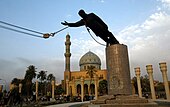
On March 20, 2003, a United States-organized coalition invaded Iraq, with the stated reason that Iraq had failed to abandon its nuclear and chemical weapons development program in violation of U.N. Resolution 687. These claims were based on documents that were provided by the CIA and the government of the United Kingdom.[52] However, no weapons of mass destruction have been found,[53] and the 2004 Duelfer Report found that all nuclear and chemical weapons research had ended by the mid-1990s.[54]
Following the invasion, the United States established the Coalition Provisional Authority to govern Iraq. In May 2003 L. Paul Bremer, the chief executive of the CPA, issued orders to exclude Baath Party members from the new Iraqi government (CPA Order 1) and to disband the Iraqi Army (CPA Order 2).[55] The decision to dissolve the army was blamed for leading many Sunnis, who led much of the army, to join the insurgency against American occupation.[56] The exclusion of people who belonged to the ruling party and the abolition of whole ministries were considered to have gutted the state and helped bring about chaos.[57]
The years following the invasion saw insurgency against Coalition and government troops as well as intense violence between Sunnis and Shias.[58] The Mahdi Army, a Shia militia created in the summer of 2003 by Moqtada Sadr,[59] reached some 60,000 members by December 2006.[59] Al-Qaeda in Iraq targeted Shia Muslims.[60] By 2007, the violence had increased to the point of being described in the United States' National Intelligence Estimate as a civil war. On December 30, 2006, Saddam Hussein was hanged.[61] Some of his closest associates were also executed.[62][63] Ali Hassan al-Majid (aka Chemical Ali) was executed in 2010 for his role in the Halabja poison gas attack in 1988.[64]
There have since been many attacks on Iraqi minorities such as the Yezidis, Mandeans, Assyrians and others. A U.S. troop surge was enacted to deal with increased violence,[65] which began to abate from the summer of 2007.[66] Iraq also suffered a cholera outbreak in 2007.[67]
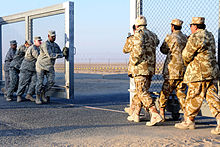
Crime and violence initially spiked in the months following the US withdrawal from cities.[68][69] Despite the initial increase in violence, in November 2009, Iraqi Interior Ministry officials reported that the civilian death toll in Iraq fell to its lowest level since the 2003 invasion.[70]
U.S. troops handed over security duties to Iraqi forces in June 2009, though they continued to work with Iraqi forces after the pullout.[71] On the morning of December 18, 2011, the final contingent of U.S. troops to be withdrawn ceremonially exited over the border to Kuwait.[9]
The Iraqi National Movement, reportedly representing the majority of Iraqi Sunnis, boycotted Parliament for several weeks in late 2011 and early 2012, claiming that the Shiite-dominated government was striving to sideline Sunnis. In January 2012, Vice President Tariq al-Hashimi, a Sunni, fled to the semi-autonomous Kurdish region after the government accused him of running a sectarian death squad.[72]
In February 2011 the Arab Spring protests spread to Iraq;[73] however, the initial protests had largely ended by the end of 2011. In December 2012, a new series of protests began, largely driven by Sunni Arabs who feel marginalized by Iraq's Shia government.[74][75] Sectarian violence continued in the first half of 2013.[76] More than 1,000 people were killed in the May 2013 Iraq attacks, making it the deadliest month since the 2006–2007 civil war.[77]
Geography
Iraq lies between latitudes 29° and 38° N, and longitudes 39° and 49° E (a small area lies west of 39°). Spanning 437,072 km2 (168,754 sq mi), it is the 58th-largest country in the world. It is comparable in size to the US state of California, and somewhat larger than Paraguay.
Iraq mainly consists of desert, but near the two major rivers (Euphrates and Tigris) are fertile alluvial plains, as the rivers carry about 60,000,000 m3 (78,477,037 cu yd) of silt annually to the delta. The north of the country is mostly composed of mountains; the highest point being at 3,611 m (11,847 ft) point, unnamed on the map opposite, but known locally as Cheekah Dar (black tent). Iraq has a small coastline measuring 58 km (36 mi) along the Persian Gulf. Close to the coast and along the Shatt al-Arab (known as arvandrūd: اروندرود among Iranians) there used to be marshlands, but many were drained in the 1990s.
Climate
Most of Iraq has a hot arid climate with subtropical influence. Summer temperatures average above 40 °C (104 °F) for most of the country and frequently exceed 48 °C (118.4 °F). Winter temperatures infrequently exceed 21 °C (69.8 °F) with maxima roughly 15 to 19 °C (59.0 to 66.2 °F) and night-time lows 2 to 5 °C (35.6 to 41.0 °F). Typically precipitation is low; most places receive less than 250 mm (9.8 in) annually, with maximum rainfall occurring during the winter months. Rainfall during the summer is extremely rare, except in the far north of the country. The northern mountainous regions have cold winters with occasional heavy snows, sometimes causing extensive flooding.
Government and politics
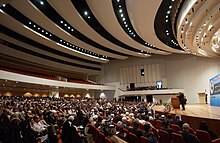
The federal government of Iraq is defined under the current Constitution as a democratic, federal parliamentary Islamic republic. The federal government is composed of the executive, legislative, and judicial branches, as well as numerous independent commissions. Aside from the federal government, there are regions (made of one or more governorates), governorates, and districts within Iraq with jurisdiction over various matters as defined by law.
The National Alliance is the main Shia parliamentary bloc, and was established as a result of a merger of Prime Minister Nouri Maliki's State of Law Coalition and the Iraqi National Alliance.[78] The Iraqi National Movement is led by Iyad Allawi, a secular Shia widely supported by Sunnis. The party has a more consistent anti-sectarian perspective than most of its rivals.[78] The Kurdistan List is dominated by two parties, the Kurdistan Democratic Party led by Masood Barzani and the Patriotic Union of Kurdistan headed by Jalal Talabani. Both parties are secular and enjoy close ties with the West.[78]
In 2010, according to the Failed States Index, Iraq was the world's seventh most politically unstable country.[79][80] The concentration of power in the hands of Prime Minister Nouri al-Maliki and growing pressure on the opposition have led to growing concern about the future of political rights in Iraq.[81] Nevertheless progress has been made and the country had risen to 11th place by 2013.[82]
Since the establishment of the "no–fly zones" following the Gulf War of 1990–1991, the Kurds have established their own autonomous region. This has been a source of particular tension with Turkey.
Law
In October 2005, the new Constitution of Iraq was approved in a referendum with a 78% overall majority, although the percentage of support varying widely between the country's territories.[83] The new constitution was backed by the Shia and Ķurdish communities, but was rejected by Arab Sunnis. Under the terms of the constitution, the country conducted fresh nationwide parliamentary elections on December 15, 2005. All three major ethnic groups in Iraq voted along ethnic lines.
Law no. 188 of the year 1959 (Personal Status Law)[84] made polygamy extremely difficult, granted child custody to the mother in case of divorce, prohibited repudiation and marriage under the age of 16.[85] Article 1 of Civil Code also identifies Islamic law as a formal source of law.[86] Iraq had no Sharia courts but civil courts used Sharia for issues of personal status including marriage and divorce. In 1995 Iraq introduced Sharia punishment for certain types of criminal offenses.[87] The code is based on French civil law as well as Sunni and Jafari (Shi’ite) interpretations of Sharia.[88]
In 2004, the CFA chief executive L. Paul Bremer said he would veto any constitutional draft stating that sharia is the principal basis of law.[89] The declaration enraged many local Shia clerics,[90] and by 2005 the United States had relented, allowing a role for sharia in the constitution to help end a stalemate on the draft constitution.[91]
The Iraqi Penal Code is the statutory law of Iraq.
Military
Iraqi security forces are composed of forces serving under the Ministry of Interior and the Ministry of Defense, as well as the Iraqi Counter Terrorism Bureau, reporting directly to the Prime Minister of Iraq, which oversees the Iraqi Special Operations Forces. Ministry of Defense forces include the Iraqi Army, the Iraqi Air Force and the Iraqi Navy. The Peshmerga are a separate armed force loyal to the Kurdistan Regional Government. The regional government and the central government disagree as to whether they are under Baghdad's authority and to what extent.[92]
The Iraqi Army is an objective counter-insurgency force that as of November 2009 includes 14 divisions, each division consisting of 4 brigades.[93] It is described as the most important element of the counter-insurgency fight.[94] Light infantry brigades are equipped with small arms, machine guns, RPGs, body armor and light armored vehicles. Mechanized infantry brigades are equipped with T-54/55 main battle tanks and BMP-1 infantry fighting vehicles.[94] As of mid-2008, logistical problems included a maintenance crisis and ongoing supply problems.[95]
The Iraqi Air Force is designed to support ground forces with surveillance, reconnaissance and troop lift. Two reconnaissance squadrons use light aircraft, three helicopter squadrons are used to move troops and one air transportation squadron uses C-130 transport aircraft to move troops, equipment, and supplies. It currently has 3,000 personnel. It is planned to increase to 18,000 personnel, with 550 aircraft by 2018.[94]
The Iraqi Navy is a small force with 1,500 sailors and officers, including 800 Marines, designed to protect shoreline and inland waterways from insurgent infiltration. The navy is also responsible for the security of offshore oil platforms. The navy will have coastal patrol squadrons, assault boat squadrons and a marine battalion.[94] The force will consist of 2,000 to 2,500 sailors by year 2010.[96]
Foreign relations
|
|
This section requires expansion. (June 2012) |
On November 17, 2008, the U.S. and Iraq agreed to a Status of Forces Agreement,[97] as part of the broader Strategic Framework Agreement.[98] This agreement states "the Government of Iraq requests" U.S. forces to temporarily remain in Iraq to "maintain security and stability," and that Iraq has jurisdiction over military contractors, and US personnel when not on US bases or on–duty.
On 12 February 2009, Iraq officially became the 186th State Party to the Chemical Weapons Convention. Under the provisions of this treaty, Iraq is considered a party with declared stockpiles of chemical weapons. Because of their late accession, Iraq is the only State Party exempt from the existing timeline for destruction of their chemical weapons. Specific criteria is in development to address the unique nature of Iraqi accession.[99]
Iran–Iraq relations have flourished since 2005 by the exchange of high level visits: Iraqi PM Nouri al-Maliki makes frequent visits, along with Jalal Talabani visiting numerous times, to help boost bilateral cooperation in all fields. A conflict occurred in December 2009, when Iraq accused Iran of seizing an oil well on the border.[100]
Relationships with Turkey are tense, largely because of the Kurdistan Regional Government, as clashes between Turkey and the PKK continue.[101] In October 2011, the Turkish parliament renewed a law that gives Turkish forces the ability to pursue rebels over the border in Iraq."[102]
Human rights
Relations between Iraq and its Kurdish population have been sour in recent history, especially with Saddam Hussein's genocidal campaign against them in the 1980s. After uprisings during the early 90s, many Kurds fled their homeland and no-fly zones were established in northern Iraq to prevent more conflicts. Despite historically poor relations, some progress has been made, and Iraq elected its first Kurdish president, Jalal Talabani, in 2005. Furthermore, Kurdish is now an official language of Iraq alongside Arabic according to Article 4 of the constitution.[103]
LGBT rights in Iraq remain limited. Although decriminalized, homosexuality remains stigmatized in Iraqi society. Targeting people because of their gender identity or sexual orientation is not uncommon and is usually carried out in the name of family honor. People who dress in emo style are mistakenly associated with homosexuality and may suffer the same fate.[104] A BBC article published in 2009, which includes interviews of homosexual and transgendered Iraqis, suggests that LGBT people were less subject to violence under Hussein's regime.

 Meher Baba's Life & Travels
Meher Baba's Life & Travels



























